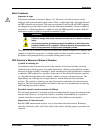
Appendices
January 2009 UDA2182 Universal Dual Analyzer Product Manual 207
Batch Treatment
Sequence of steps
Continuous treatment is shown in Figure 15-3. However, all of the reactions can be
achieved with semi-automatic batch control. Only a single tank with a pH controller and
an ORP controller are required. The steps are sequenced, and the pH and ORP setpoints
are changed to give the same results as for the continuous treatment. Caustic is added to
raise pH to 11; then hypochlorite is added to raise the ORP potential to about +450 mV
while more caustic is added as required to maintain 11 pH.
WARNING
Failure to comply with these instructions could result in death or serious
injury.
An interlock must be provided to prevent the addition of acid before the
positive oxidation of ALL cyanide. Failure to observe this precaution can
result in the generation of highly toxic hydrogen cyanide.
Then the acid can be added to neutralize the batch and further oxidation will complete the
cyanate-to-carbonate conversion. A settling period can then be used to remove solids, or
the batch can be pumped directly to another settling tank or pond.
ORP Potential a Measure of Status of Reaction
Cyanide is reducing ion
An oxidation-reduction reaction involves the transfer of electrons from the ion being
oxidized to the oxidizing agent. In cyanide destruction, chlorine or hypochlorite accepts
electrons from the cyanide, oxidizing it, while simultaneously the hypochlorite is reduced
to chloride. ORP potential is a measure of the status of the oxidation-reduction reaction;
i.e., the gold electrode detects the solution’s ability to accept or donate electrons. The
hypochlorite, an oxidizing ion, accepts electrons, which makes the electrode more
positive. The cyanide, a reducing ion, provides electrons and makes the electrode more
negative. The net electrode potential is related to the ratio of concentrations of reducing
and oxidizing ions in the solution.
Potential cannot be used as monitor of effluent
This electrode potential is extremely sensitive in measuring the degree of treatment in the
reaction tank. However, it cannot be related to a definite concentration of a cyanide or
cyanate; therefore it cannot be used as a monitor of final effluent concentration.
Importance of clean electrode
Reliable ORP measurement requires a very clean metal electrode surface. Routinely
clean the electrodes with a soft cloth, dilute acids, and/or cleaning agents to promote fast
response.


















